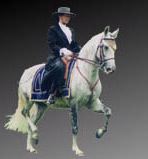 |
classicaldressagescotland.com |
| Lesson 9: Improving the Basic Paces |
| New web address: www.classicaldressagescotland.com |  |
| About this site | About us | Personal Tuition | Video analysis | Lesson menu | Portugal and Lusitanos |
| Home Schooling Classical dressage Modern dressage Horse trials Show jumping Glossary Links |
You wake up in the morning and you decide, in a flash of inspiration, that you
no longer want to be a professional hang gliding instructor but what you really
want to do with your life is to be a weight lifter. You want to go to the Olympics
and represent your county and ultimately win a gold medal.
The logical first step in this major career change would be to find a gymnasium that specializes in weight lifting and get advice how to proceed. Now imagine its your first morning at your new gym and you tell your instructor that you would like to go over to that huge pile of weights in the corner and lift the 200 pound dumbbell straight away please. I guarantee that your instructor, after much giggling and calling his friends over to point at you and muttering something about "as much use as a chocolate fire-grate" and "legs like pipe cleaners", will inform you that your expectations and goals were a little high sir or madam and that some sort of preparation must be done. Then perhaps, and if you trained every day, (time off for good behavior and church on Sundays), you might lift a 200 pound weight without doing yourself a serious injury, in about a year or two. The same rules apply to your horse. He must be prepared and physically trained to build muscle, balance, technique and mental attitude to be able to carry himself and you in dressage. To improve his basic paces, to make more beautiful the way he moves across the ground and turn this animal into an art form. This will take time and patience and a lot of thought. So what are the major factors, the equine equivalent of gymnastics that you will need to turn your ugly duckling into an international dressage star. Your horse will need
You, the rider will need exactly the same except substitute obedience for dedication. And how are you going to achieve all these things.
This lesson will concentrate just on straightness on a single track and the correct practice of lengthening and shortening the stride Straightness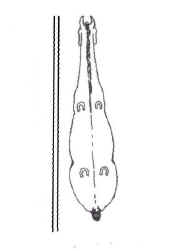
If you are riding along the long side of your school and the horseís side is parallel with the track or the wall, your horse is not straight. It will feel straight, but in fact the hindquarters are a little to one side; to the inside. Therefore you are losing the propulsive power of the hind legs. The hind legs will not be pushing forwards through the spine, and the power will be pushing to one side. Remember, the horseís shoulders are narrower than his hips. If he is hugging the side of the school with his whole body, the spine cannot be parallel. In single-track work the hind feet must follow directly in the tracks of the fore feet rather than stepping to one side to avoid discomfort of carrying and propelling his weight and bad habit. So how do we make our horse straight? 
Remember that this exercise is just for straightening your horse on a single track along the long side of the school. Establishing straightness can be a slow process, taking months or even years. This is because the horse has to build up muscle and get into the habit of carrying himself correctly. There will be more about straightness in turns and circles and school movements in a future lesson I have found that this exercise is best ridden in trot. You will have more impulsion and power to play with and as you have to take the rein back you will need to have forwardness. 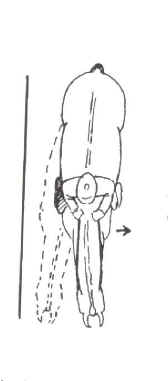
Ride you horse down the long side of the school. Ride a correct corner. As your horse hugs the boards or the wall of the school, take a little more contact in the inside rein, momentarily block. This is to stop the horseís head and neck bending to the outside. Then draw back with the outside rein so bringing the shoulder off the wall. If necessary, back this up with a little pressure from the outside leg. As soon as your horse is straight, soften both reins; ride forward with equal feel in both hands. When your horse is equally easy to ride on both reins with equal contact, he will be straight. But always check if he is hugging the boards or if he is carrying his propulsive power from the hind legs through a straight and parallel spine. If itís the former, keep working. Straightness for a dressage horse cannot be understated. Its really important, and this will become even more evident when we come to school turns and circles and the advanced movements such as flying changes, piaffe and passage. Lengthening and Shortening StridesFrequent changes from working / collection to extension and vice versa at both trot and canter are an excellent means of teaching the horse to control his balance. They improve his capacity for longitudinal flexion, which will enable him to lower his haunches, carry more impulsion in the hindquarters and become stronger. The forehand will become lighter and the paces will become more energetic. When your horse is straight, you can start work on the transitions from working trot / canter or collected trot / canter, to extension or lengthened strides. In working trot, make sure you are riding your corners correctly and that your horse is straight. When you get to the next long side, half halt and then ask your horse to go faster, but in the same tempo as the previous pace. Make your horse go from point A to point B faster but in the same rhythm as the working or collect trot or working or collected canter. The contact with the bit and the tempo must remain the same throughout the exercise. If you have to rise at the trot during the lengthened strides, is doesnít matter so long as the contact and the tempo remain the same. The transition can be progressive, but most benefit will be gained if your horse is sharp from the leg and goes straight into lengthened strides with one squeeze. Donít let your horse fall onto his forehand in the transition. Think "uphill"í. On the transition back down to working / collected trot or cater, again donít let the horse fall onto his forehand. Ride a half halt and use the power you have created in the lengthened strides to engage the hindquarters. You will then be swapping / exchanging forward momentum for elevation. And once again, think "uphill". More on lengthened strides and the extended paces in a future lesson. 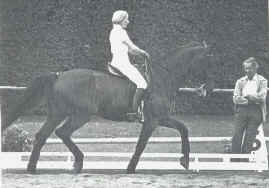
Here are two pictures of Christine Stockelberger from Switzerland doing the exact same exercise as she prepares Granat for the alternative Olympic Games in 1981. 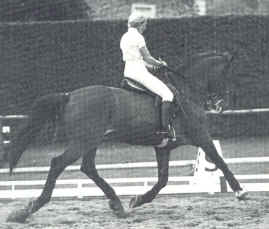
When you are trying to improve your horse's basic paces, donít get too one track minded. "All work and no play makes Jack a dull boy". The same applies to your horse. Hack out a couple of times a week. A lot of hill work is good for building muscles and stamina and even a few low jumps can work miracles for balance and confidence. There are quite a few more techniques for improving the paces and hopefully the subject comes up in your emails so that we can discuss what would be best for your horse. If you would like a further lesson on this subject, just let me know. I hope you enjoy this lesson. If you have any comments or problems, please get back to me. And donít forget, the animal underneath you is doing all the work, let him know that you know and show gratitude for the effort he puts in.
|